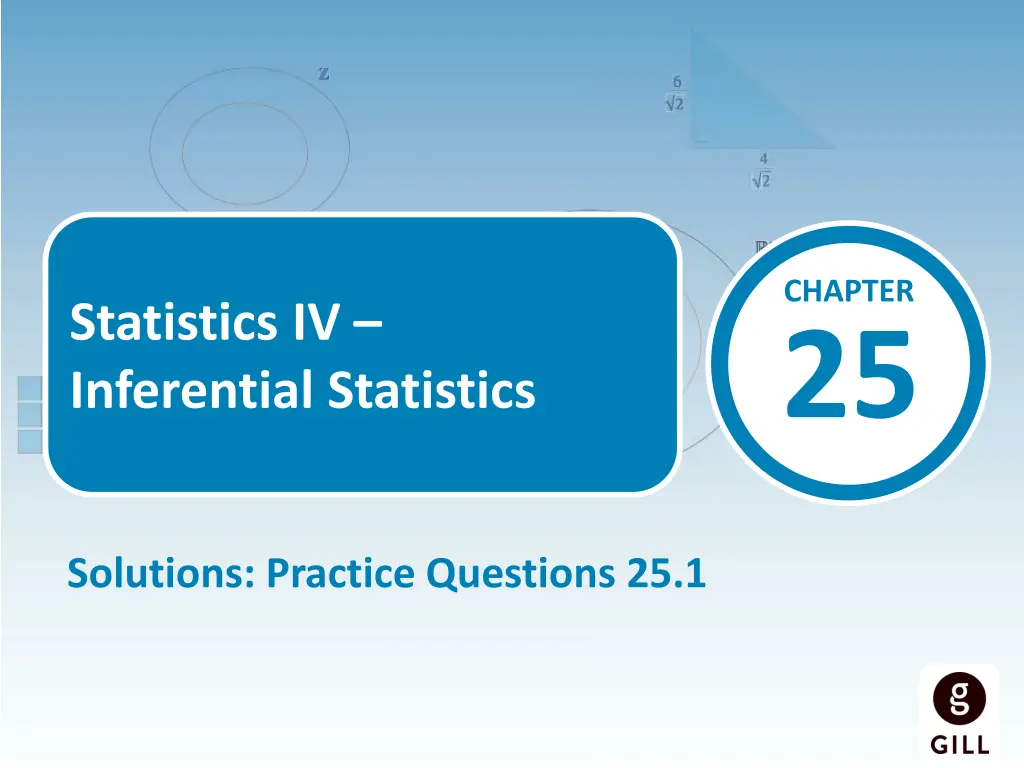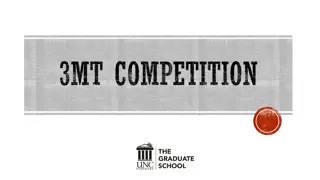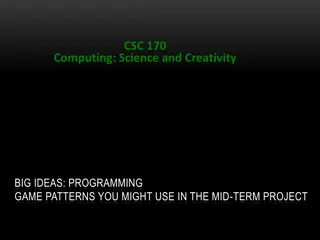
Statistics IV: Inferential Statistics Practice Questions Solutions
"Explore solutions for practice questions on inferential statistics, including percentages in normal distribution curves, mean, standard deviation, and IQ score calculations. Understand the distribution of IQ scores and percentages above, below, and within standard deviations from the mean."
Download Presentation

Please find below an Image/Link to download the presentation.
The content on the website is provided AS IS for your information and personal use only. It may not be sold, licensed, or shared on other websites without obtaining consent from the author. If you encounter any issues during the download, it is possible that the publisher has removed the file from their server.
You are allowed to download the files provided on this website for personal or commercial use, subject to the condition that they are used lawfully. All files are the property of their respective owners.
The content on the website is provided AS IS for your information and personal use only. It may not be sold, licensed, or shared on other websites without obtaining consent from the author.
E N D
Presentation Transcript
CHAPTER 25 Statistics IV Inferential Statistics Solutions: Practice Questions 25.1
25 Practice Questions 25.1 1. What percentage of the following normal distribution curves is shaded? (i) = 68%
25 Practice Questions 25.1 1. What percentage of the following normal distribution curves is shaded? (ii) 3 = 99 7%
25 Practice Questions 25.1 1. What percentage of the following normal distribution curves is shaded? (iii) = 68%. Since the curve is symmetrical, 68 2 = = 34%
25 Practice Questions 25.1 1. What percentage of the following normal distribution curves is shaded? (iv) 81 5% (68% + 13 5%)
25 Practice Questions 25.1 2. The normal curve shown below represents the distribution of IQ scores for a population. What is the mean? (i) Mean = 100 (Centre of normal curve)
25 Practice Questions 25.1 2. The normal curve shown below represents the distribution of IQ scores for a population. What is the standard deviation? (ii) Standard deviation = 115 100 = 15
25 Practice Questions 25.1 2. The normal curve shown below represents the distribution of IQ scores for a population. Calculate the value of 2 . (iii) 2 = 100 2(15) = 100 30 = 70
25 Practice Questions 25.1 2. The normal curve shown below represents the distribution of IQ scores for a population. What percentage of the population have an IQ score between 85 and 115? (iv) 85 115 = + = 68%
25 Practice Questions 25.1 3. Given an approximately normal distribution, what percentage of all values are: above the mean? (i) 50% (the normal curve is symmetrical) below the mean? (ii) 50% (the normal curve is symmetrical) within one standard deviation from the mean? (iii) 68%
25 Practice Questions 25.1 3. Given an approximately normal distribution, what percentage of all values are: within two standard deviations from the mean? (iv) 95% within three standard deviations from the mean? (v) 99 7% and what interval contains 99 7% of all values? (vi) + 3 3
25 Practice Questions 25.1 4. For each of the following, find the interval in which (a) 68%, (b) 95% and (c) 99 7% of data lies. Mean = 16 Standard deviation = 3 (i) (a) 68% = = 16 3 16 + 3 = 13 19 (b) 95% = 2 = 16 6 16 + 6 = 10 22 (c) 99 7% = 3 = 16 9 16 + 9 = 7 25
25 Practice Questions 25.1 4. For each of the following, find the interval in which (a) 68%, (b) 95% and (c) 99 7% of data lies. Mean = 5 2 Standard deviation = 0 8 (ii) (a) 68% = = 5 2 0 8 5 2 + 0 8 = 4 4 6 (b) 95% = 2 = 5 2 1 6 5 2 + 1 6 = 3 6 6 8 (c) 99 7% = 3 = 5 2 2 4 5 2 + 2 4 = 2 8 7 6
25 Practice Questions 25.1 4. For each of the following, find the interval in which (a) 68%, (b) 95% and (c) 99 7% of data lies. Mean = 148 Standard deviation = 6 (iii) (a) 68% = = 148 6 148 + 6 = 142 154 (b) 95% = 2 = 148 12 148 + 12 = 136 160 (c) 99 7% = 3 = 148 18 148 + 18 = 130 166
25 Practice Questions 25.1 4. For each of the following, find the interval in which (a) 68%, (b) 95% and (c) 99 7% of data lies. Mean = 68 Standard deviation = 4 6 (iv) (a) 68% = = 68 4 6 68 + 4 6 = 63 4 72 6 (b) 95% = 2 = 68 9 2 68 + 9 2 = 58 8 77 2 (c) 99 7% = 3 = 68 13 8 68 + 13 8 = 54 2 81 8
25 Practice Questions 25.1 4. For each of the following, find the interval in which (a) 68%, (b) 95% and (c) 99 7% of data lies. Mean = 250 Standard deviation = 31 5 (v) (a) 68% = = 250 31 5 250 + 31 5 = 218 5 281 5 (b) 95% = 2 = 250 63 250 + 63 = 187 313 (c) 99 7% = 3 = 250 94 5 250 + 94 5 = 115 5 344 5
25 Practice Questions 25.1 5. The heights of male students is normally distributed with a mean of 170 cm and a standard deviation of 8 cm. Find the percentage of male students whose height is: greater than 186 cm (i) 186 = 170 + 16 170 + 2(8) This means that greater than 186 cm is the area above + 2 . Percentage above 2 = 2 35% + 0 15% (from graph) = 2 5%
25 Practice Questions 25.1 5. The heights of male students is normally distributed with a mean of 170 cm and a standard deviation of 8 cm. Find the percentage of male students whose height is: between 162 cm and 186 cm (ii) 170 162 = 8 162 = The area between 162 and 186 is the area from + 2 Percentage from + 2 = 68% + 13 5% (From graph) = 81 5%
25 Practice Questions 25.1 5. The heights of male students is normally distributed with a mean of 170 cm and a standard deviation of 8 cm. Find the percentage of male students whose height is: between 154 cm and 178 cm. (iii) 170 154 = 16 = 2(8) 154 = 2 178 170 = 8 178 = +
25 Practice Questions 25.1 5. The heights of male students is normally distributed with a mean of 170 cm and a standard deviation of 8 cm. Find the percentage of male students whose height is: between 154 cm and 178 cm. (iii) The area between 154 and 178 is the area from 2 + Percentage from 2 + = 13 5% + 68% = 81 5%
25 Practice Questions 25.1 6. The mean battery life of a mobile phone battery is 14 hours. Assuming that the battery life is normally distributed and the standard deviation is two hours, what percentage of the batteries have a life of between 12 and 18 hours? (i) 12 18 hours 12 hours 14 12 = 2 hours = 12 = 18 hours 18 14 = 4 hours = 2 18 = + 2
25 Practice Questions 25.1 6. The mean battery life of a mobile phone battery is 14 hours. Assuming that the battery life is normally distributed and the standard deviation is two hours, what percentage of the batteries have a life of between 12 and 18 hours? (i) The area between 12 and 18 hours is the area from + 2 12 18 hours = + 2 = 68% + 13 5% = 81 5%
25 Practice Questions 25.1 6. Batteries that have a life of less than eight hours are rejected. On a particular day a mobile battery production unit makes 1,200 batteries. How many batteries would you expect to be rejected on this day? (ii) Less than 8 hours 14 8 = 6 = 3(2) 8 = 3 Percentage < 8 hours = 0 15% 1,200 batteries a day 0 15% of 1,200 = 1 8 batteries rejected that day.
25 Practice Questions 25.1 7. The results of 20 students in their end-of-term maths exam were: 45, 56, 67, 85, 28, 64, 72, 83, 48, 96, 47, 71, 59, 63, 54, 66, 79, 80, 42, 50 Find the mean of this data. (i) sum of numbers number of numbers Mean = =45+56+67+85+28+64+72+83+48+96+47+71+59+63+54+66+79+80+42+50 20 =1255 20 =62 75
25 Practice Questions 25.1 7. The results of 20 students in their end-of-term maths exam were: 45, 56, 67, 85, 28, 64, 72, 83, 48, 96, 47, 71, 59, 63, 54, 66, 79, 80, 42, 50 Find the standard deviation to 2 decimal places. (ii) Standard deviation: 16 54 (by calculator)
25 Practice Questions 25.1 7. The results of 20 students in their end-of-term maths exam were: 45, 56, 67, 85, 28, 64, 72, 83, 48, 96, 47, 71, 59, 63, 54, 66, 79, 80, 42, 50 Assuming that the results are normally distributed, find the interval in which: (iii) (a) 68% of the data lies 68% = + = 62 75 = 16 54 = 62 75 16 54 = 46 21 = 62 75 + 16 54 + = 79 29 68% of the data lies between 46 21 79 29
25 Practice Questions 25.1 7. The results of 20 students in their end-of-term maths exam were: 45, 56, 67, 85, 28, 64, 72, 83, 48, 96, 47, 71, 59, 63, 54, 66, 79, 80, 42, 50 Assuming that the results are normally distributed, find the interval in which: (iii) (b) 95% of the data lies 95% = 2 + 2 2 = 62 75 2(16 54) = 29 67 = 62 75 + 2(16 54) + 2 = 95 83 95% of the data lies between 29 67 95 83
25 Practice Questions 25.1 7. The results of 20 students in their end-of-term maths exam were: 45, 56, 67, 85, 28, 64, 72, 83, 48, 96, 47, 71, 59, 63, 54, 66, 79, 80, 42, 50 Assuming that the results are normally distributed, find the interval in which: (iii) (c) 99 7% of the data lies. 99 7% = 3 + 3 3 = 62 75 3(16 54) = 13 13 = 62 75 + 3(16 54) + 3 = 112 37 99 7% of the data lies between 13 13 112 37
25 Practice Questions 25.1 8. At a certain IT company, the ages of all new employees hired during the last five years are normally distributed. Within this curve, 95% of the ages are between 24 6 and 37 4 years. Find the mean age and the standard deviation of the data. = 24 6 37 4 95% = 2 + 2 24 6 = 2 37 4 = + 2
25 Practice Questions 25.1 8. At a certain IT company, the ages of all new employees hired during the last five years are normally distributed. Within this curve, 95% of the ages are between 24 6 and 37 4 years. Find the mean age and the standard deviation of the data. Solve these equations simultaneously: 24 6=m- 2s 37 4=m+ 2s 62 = 2 (divide both sides by 2) 31 = 24 6 = (31) 2 (substitute into equation ) 2 = 31 24 6 2 = 6 4 = 3 2
25 Practice Questions 25.1 9. Given + 1 = 247 and + 2 = 428 find: the standard deviation (i) + 1 = 247 + 2 = 428 Solve these equations simultaneously: m +s =247 -m -2s =-428 = 181 = 181
25 Practice Questions 25.1 9. Given + 1 = 247 and + 2 = 428 find: the mean (ii) + (181) = 247 (substitute into equation ) = 247 181 = 66
25 Practice Questions 25.1 9. Given + 1 = 247 and + 2 = 428 find: the approximate percentage of the distribution that lies between 66 and 428. (iii) 66 428 = %? 66 = 428 = 362 428 66 = 2(181) = 2 + 2 34% + 13 5% = 47 5%








